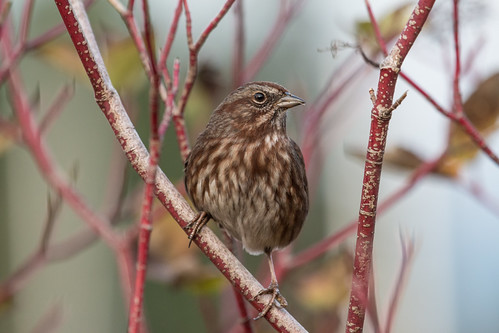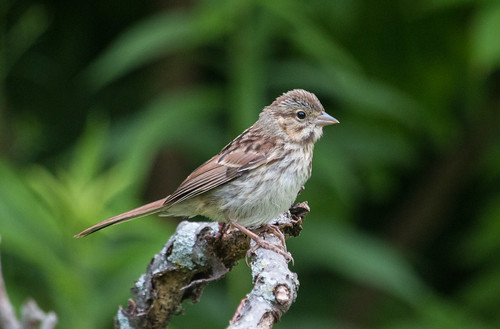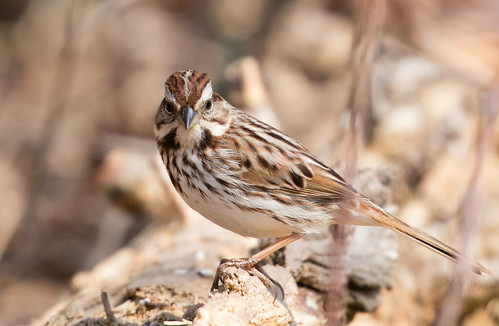Last month, I read a wonderful letter from 9-year-old listener Aleda. She wrote mostly about chickadees, but also mentioned that one of her favorite birds is the Song Sparrow. I promised I’d do a program about them today.
Why May 11, specifically? On May 11, 1935, one of the world’s seminal bird researchers, Margaret Morse Nice, spent the entire day, from midnight to midnight, following one particular Song Sparrow near her home in Columbus, Ohio, and recording every one of his behaviors. The little bird, whose color band made recognizing him easy, was nicknamed 4M. On that day, he spent roughly 10 hours singing, 9 hours roosting, and 5 hours eating and doing other miscellaneous Song Sparrow activities. During those 10 hours of song bouts, he sang 2,305 complete songs. Some of Nice’s earliest papers were too rich in detail and scope to be suited to the norms of American ornithological journals at the time and were published in Germany instead. Her 2-volume work, Studies in the Life History of the Song Sparrow, which set the gold standard for meticulous work on any single species, was originally published in the Transactions of the Linnean Society of New York. My copy is a Dover reprint.
The Song Sparrow is one of the widest ranging of all our songbirds, breeding across the northern and most of the central states and up to Hudson Bay in Canada, spanning all of British Columbia and coastal Alaska to much of Quebec and a chunk of Newfoundland and Labrador. Some populations live year-round in Mexico.
Having such a broad range gives the Song Sparrow quite a range in body size, with the largest, found in beach grass in the Aleutians, having 150% of the body mass of the smallest, living in California salt marshes. Both these Pacific Coast populations show extreme site fidelity, often defending their territories year-round. This limits each individual’s choices of mates compared with populations that migrate and wander as the landscape changes over time. So those coastal populations become rather isolated, developing some unique differences from most Song Sparrows whose populations move about, undergoing more genetic mixing over time.
 |
| This Song Sparrow was photographed in Vancouver in British Columbia. |
Song Sparrow songs also vary enormously, both geographically and individually, in the same way that English-speaking Americans and Canadians have regional accents and dialects. Wherever I’ve traveled, I’ve thrilled at the differences in Song Sparrow local dialects. I’ve always been able to recognize their songs, though when I’m in any unfamiliar area, I try to track down as many singers as I can just in case there’s a species that sounds enough like a Song Sparrow that I might not realize it isn’t. They virtually always start with two or three identical notes at the start and then break into a jumble. Song Sparrows perform in the background of a lot of the soundscape recordings I 've made; I've also made a few recordings specifically of them. All of them are linked on my Song Sparrow species page.
 |
| Laura not only photographed this individual Song Sparrow on Audubon's Hog Island in Maine, she recorded an 11-minute singing bout in which he sang 48 songs from start to finish. You can listen to the recording (with the ocean and a lobster boat, and an airplane, in the background) here. |
Song Sparrows arrive fairly early in spring, often with or soon after the first juncos and before Fox Sparrows. Mine had been singing up a storm for a few weeks, but now I think they’re busy nesting. I never ever look for their nests—I’m afraid my scientific curiosity is completely overpowered by my fear of giving away the nest’s location to predators. In my own yard, my crows and Blue Jays fly in whenever I go out, hoping for peanuts, so no way could I look for nests here.
 |
| I came upon this fairly recently fledged Song Sparrow in Madison, Wisconsin. |
The only nest I’ve ever tracked closely in my yard has been this year’s chickadee nest in my dead cherry tree, and because it was excavated by the chickadees, the entrance is just too tiny for even the smallest Blue Jay to access. Open nests are much more vulnerable, so I’ll have to continue my long standing track record of being lackadaisical, rather the polar opposite of my hero Margaret Morse Nice. I’ll sit around in my lazy way, watching and enjoying my Song Sparrows whenever they choose to let me.
I hope Aleda is enjoying her Song Sparrows as much as I'm enjoying mine!



